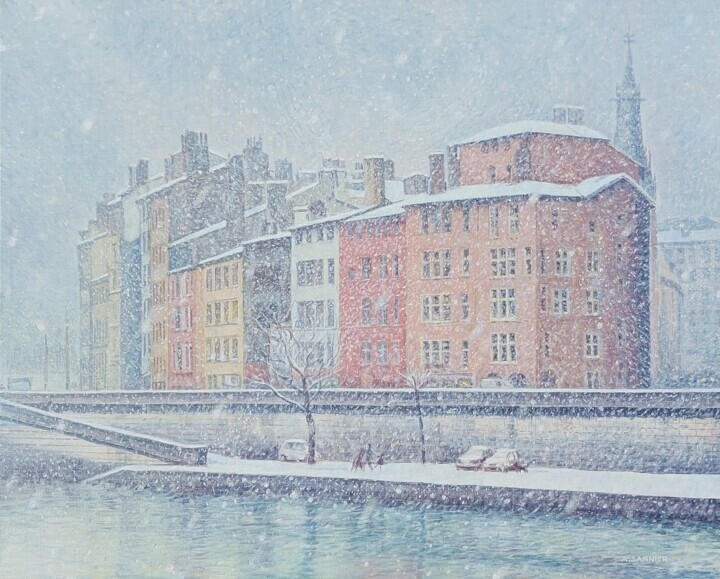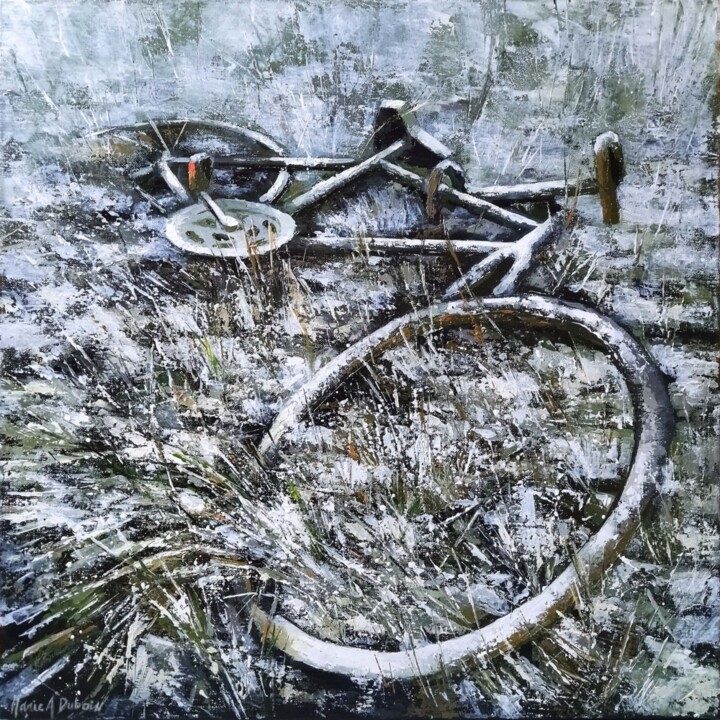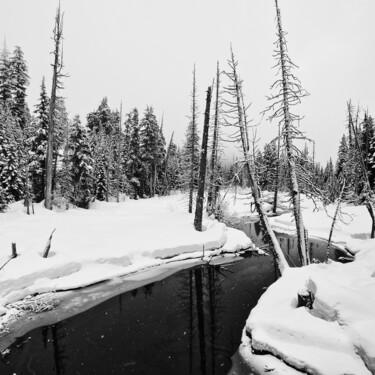 TAXI DANS LA NEIGE (2018)Painting by Raymond Agostini
TAXI DANS LA NEIGE (2018)Painting by Raymond Agostini
Fleece blankets and Netflix
We are nearing the arrival of winter, and I felt I couldn't overlook this occasion, celebrating it with cozy pajamas, duvets, hot beverages, soups, Netflix, fleece blankets, and a furry companion on our laps. But from a historical-artistic perspective, how could I commemorate this special time of year, which also happens to coincide with Christmas? I have decided to postpone writing the top 10 snow paintings list until possibly 2024, as for now, I'd like to delve into the subject, analyzing it within a specific figurative context: that of Flemish art and the Golden Age, known for its ice skaters enlivening pristine yet chilly landscapes. This narrative will be structured as follows: I will begin by explaining what is meant by Flemish art, showcase the masters of the snowy period, move on to the Golden Age, and highlight other great artists in colder temperatures. Are you ready? I invite you to put on your warmest blanket, the coziest pajamas in the world, sip on steaming herbal tea, and settle into a comfortable couch to immerse yourselves in the "fiction" of the narrative!
 LYON, SAINT-PAUL SOUS LA NEIGE (2006)Painting by Sannier Alain
LYON, SAINT-PAUL SOUS LA NEIGE (2006)Painting by Sannier Alain
Flemish Art
Once again, my intention is to convey without explaining, to fill you with knowledge without making it obvious, by illustrating a few but crucial key concepts that will help you place the fundamentals of Flemish art in the right chronological and comprehensible context, as I will also do for the Golden Age. Location: The term "Flemish art" is linked to its place of origin, the Flanders region, even though its influence extended to all of the Netherlands, with a particular impact on the cities of Bruges, Ghent, and Antwerp. Year: Picture yourself in the 15th century! During this period, the Netherlands experienced significant economic and cultural development, leading to a need for an authentic portrayal of what was happening, expertly executed through realism. Realism of the era: Pictorial art exhibited great attention to detail, primarily aimed at depicting daily life, the intimate, and the beauty of nature. Now, I pass the baton to the Flemish masters who merged realism and landscapes under the purity of snow!
 SNOWFLAKE WOOD (2021)Painting by Amanda Horvath
SNOWFLAKE WOOD (2021)Painting by Amanda Horvath
Masters in the Snow
The fifteenth century is the century in which we find the masters known as Flemish Primitives, while in the second part of the period in question, as well as in the sixteenth century, we can speak of the Flemish Renaissance. A master belonging to this later period of Flemish art is Jacob Grimmer, the author of "A Winter Landscape with a Village and Skaters on a Frozen River, Hunters in the Foreground," a painting in which, as mentioned earlier, we see skaters within a winter landscape. In this pictorial narrative, the admiration that the artist held for the simple daily life of village inhabitants becomes evident, a perspective where the influence of Pieter Bruegel the Elder probably made itself felt, although, as we will see, Grimmer's work lacks the moral and philosophical dimension that characterized the older master. In simple terms: how is Bruegel's influence seen in the author of "A Winter Landscape with a Village and Skaters on a Frozen River, Hunters in the Foreground"? If you observe both the aforementioned masterpiece and Bruegel's "Hunters in the Snow" (1565), both compositions feature the presence of skaters and hunters, the latter always prominently placed in the foreground. The same pattern is repeated in "Winter Landscape with Skaters and a Bird Trap" (1565), created by Pieter Bruegel the Elder. However, this work is distinguished by the presence, as indicated in the title, of a bird trap, ready to capture the viewer's full attention. In fact, this subject was conceived by the artist to convey a clear moral message, highlighting how human life, like that of a bird, passes in the carefree of ignorance... Now let's move on to the Golden Age!
 NEIGE SUR GLACEPainting by Darnal
NEIGE SUR GLACEPainting by Darnal
The Golden Age
Historically, the Golden Age refers to that glorious period extending from the late sixteenth century, flourishing in the early seventeenth century, and culminating in 1672. During this time, the Netherlands and the other six provinces of the Northern Netherlands were finally liberated from Spanish rule, leading to the establishment of the Republic of the United Provinces. This context of political independence also saw the emergence of a great artistic flourishing, primarily focused on immortalizing genre scenes, glimpses of working or leisure life, aiming to reveal the identity of a new clientele, mostly belonging to the middle or merchant class, guilds, fraternities, and private citizens. They requested works that depicted everyday life without ignoring the moral aspects of private life.
 PETITE REINE DES NEIGES (2023)Painting by Marie A Dubois
PETITE REINE DES NEIGES (2023)Painting by Marie A Dubois
Masters in the Snow
In the context explained above, works such as "Winter Scene with Skaters near a Castle" (1615) by Hendrick Avercamp, as well as "Scene on the Ice near a town" (1615), also by the same artist, and "Dutch Skaters in a Village Scene" by Jan Griffier I, come to life. In the first case, we have a circular painting depicting a fantastical urban view, once again hosting characters skating on the frozen streets. The diverse figures create a lively and diversified atmosphere. As for historical details, it's important to note that one of the sleds is decorated with a rampant lion, a probable reference to the coat of arms of the Republic of the Seven United Provinces! Let's conclude with Hendrick Avercamp's second masterpiece, similarly characterized by a multitude of subjects, representing various social classes engaged in different activities, including kolf this time. Fun fact: kolf is a Dutch recreational activity that predates modern golf! Finally, winter amusements have also been painted by Jan Griffier I, a Dutch painter and engraver of the Golden Age, specializing in landscape painting. The narrative continues with three works by the artists on Artmajeur...
 CENTRAL PARK SNOW 8 (2017)Photography by Ken Lerner
CENTRAL PARK SNOW 8 (2017)Photography by Ken Lerner
Ken Lerner: Central Park Snow 8
So far, we have been accustomed to seeing the association of snow with ice skates, which, in the context of the contemporary art I have chosen, will be set aside to showcase variations in which figurative art has portrayed the whitest time of the year. Ken Lerner's photograph presents us with a glimpse of Central Park (New York), primarily covered in snow, where some characters in heavy clothing are scattered, some static and others walking, likely heading towards the top of the photographic support. To connect the Flemish theme with that of the Artmajeur artist, I thought of mentioning some of the well-known places where ice skating can be enjoyed in the American metropolis, including the Rockefeller Center Ice Skating Rink, the Bank of America Winter Village at Bryant Park Rink, and, of course, Central Park's Wollman Rink! At this point, we can imagine another version of the same shot, more similar to those by the aforementioned masters. They were equally known for exploring the winter landscape even without skaters, as seen in the works of the renowned Bruegel, who also created "The Massacre of the Innocents," "The Adoration of the Magi in Winter Landscape," and "The Census at Bethlehem."
 SLOW ACCEPTANCE (2022)Painting by Coralie Huon
SLOW ACCEPTANCE (2022)Painting by Coralie Huon
Coralie Huon: Slow Acceptance
Until now, we had forgotten the simplest thing: stopping to observe the landscape, still, silent, and motionless, which can indeed be achieved when contemplating the painting by the Artmajeur artist, devoid of the confusion and distraction generated by human activity. However, this tranquility takes on a deeper meaning, bestowed by the very title of the artwork, which the artist sought to clarify in meaning through some accompanying verses:
After the long and arduous climb,
The calm and stillness
A moment of peace
Suspended in the heart
Along with calm and stillness, other keywords in the poetry are "long and arduous climb," conceived to remind us of how life is akin to a mountain, as there is always a climb, but at the same time, there's a moment to pause, to enjoy the landscape, being content with what we have covered so far. Speaking a bit about the artist, the French painter Coralie Huon has explored different techniques through her predominantly figurative approach, all aimed at giving voice to her desire to transform visual narratives into tangible and captivating experiences. This is primarily manifested within the landscape genre, especially in mountainous settings, to which she attributes a transformative power, remarkably suited to combine with creative inspiration.
 OVER THE RIVER AND THRU THE WOODS (2022)Painting by Tammy Gauthreaux
OVER THE RIVER AND THRU THE WOODS (2022)Painting by Tammy Gauthreaux
Tammy Gauthreaux: Over the River and Through the Woods
What would happen if we painted a snowy winter landscape, interrupted only by a small, frozen river, but off-limits to human ice skating? Who could fill this absence, felt by the canvas in the absence of more dynamism, as well as the loss of a rich variety of shapes and colors? The Artmajeur artist Tammy Gauthreaux, who answers our questions, wanted to "remedy" this lack by replacing skaters with the dynamism of some colorful balls, all seen descending from the top to the bottom of the painting, resembling a sort of descent from mountain peaks to the valley. The artist, however, clarifies the intention of these frozen spheres, revealing that they are indeed descending from the icy slope to traverse a wind-swept, cold forest path. To these clarifications, the painter adds a question, pondering where the balls might finally be headed. Unable to answer his own question, he speculates that, like Little Red Riding Hood, the spheres might even be on their way to Grandma's house...


 Olimpia Gaia Martinelli
Olimpia Gaia Martinelli























